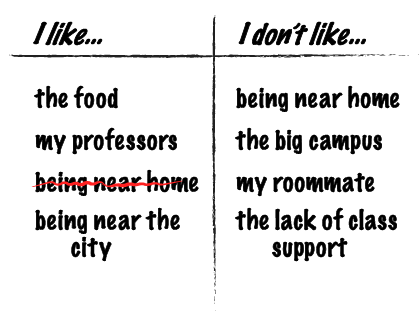So, your college experience isn’t working out the way you planned? Maybe you want to change majors, don’t click with other students, want to be closer (or farther) away from home, or you’re just not feeling it. It’s OK to ask yourself, “should I transfer colleges?” As you think through this question, this post can help you figure out how to transfer colleges by answering some common questions.
1. How do you transfer schools?
This is a broad question, but there are some simple steps to start transferring schools. First, make sure the school (or schools) you’re considering transferring to has your major. (If you aren’t sure what to major in, you can take our majors quiz for some ideas.) Second, ask yourself what you like about your current school and what you don’t like. Make a list and use that list to research schools that keep things from your “like” list and address the “don’t like” list. Here’s an example of what that may look like:

Now for step three, do your research and look for student blogs and stories to get a better feel for the college or university. If a school accepts transfer students, they’ll have a section of their admissions pages that give you all the nuts and bolts of applying. Don’t be afraid to reach out to the transfer admissions people, because they can help you navigate the transfer application and the college credit transfer process. You can connect with transfer admissions at information sessions, which are often held throughout the year to answer questions on how to transfer schools.
2. Will my credits transfer?
Transferring credits is a big part of the transfer student experience. Some universities have agreements that easily transfer credit from community colleges in the area, or they have a system to match up your existing credits to core curriculum requirements. This is called a transfer credit evaluation, or TCE, and you’ll need to submit an official transcript before your credits are applied to your new school.
You can use CollegeTransfer.net to get an idea of how your credits will transfer. It’s important to know a college or university can have special degree requirements that may not align with your credit transfer. You’ll definitely want to ask the admissions office about that, so you aren’t surprised.
3. How many credits can I transfer?
This really depends on where you decide to transfer. At Cabrini, students can transfer up to 78 credits toward their degree. Some schools, however, limit credit transfer or require you to spend a certain amount of time at their school (usually called a “residency requirement”) before being able to graduate. It’s important to know any special requirements as you’re planning.
4. Are there scholarships for transfer students?
Transfer scholarships do exist, but you’ll most likely need to meet certain academic requirements to be eligible. Schools like Cabrini offer transfer scholarships, and you can also find foundations and organizations that provide scholarships as well. U.S. News recently wrote an article on scholarships for transfer students, which may give you some leads.
If you are transferring from community college to university, you should talk to your advisor. He or she can provide more guidance, not only on scholarships, but also on any additional paperwork needed to transfer.
If the school you choose does not provide transfer student scholarships, you are still eligible for student loans and can complete your FAFSA just like you did at your current college or university.
5. What do universities look for in a transfer student?
A lot of schools will only consider transfers from accredited colleges and universities. They will also look for a lot of the same things that they do for freshmen candidates. Your transfer application will provide them with your grades, the rigor of your curriculum, and any incompletes or issues with your transcripts. Most schools have a minimum GPA requirement, which can be different depending on your planned major.
You may need to write an essay, which will help demonstrate your potential and desire to do well at the school. At the end of the day, a transfer admissions officer will try to determine if you will succeed—both academically and socially—at their university.
Transferring universities or colleges can be daunting, but there are a lot of resources out there to help you along the way. Do your research, have an idea of what you’re looking for, and talk to people!
If you’re interested in Cabrini’s undergraduate offerings, you can check out our list of majors, register for an upcoming transfer student information session, or contact our transfer admissions team.